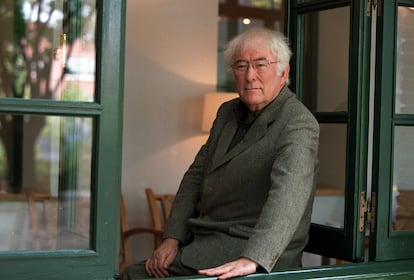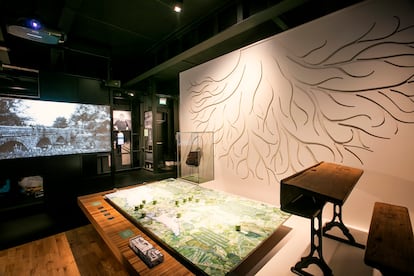A decade without Seamus Heaney, the poet of love and silence who knew how to walk on air
Ten years after Nobel laureate’s death, the museum dedicated to Ireland’s most beloved writer receives thousands of visitors


This past August marked 10 years since the death of Seamus Heaney, Northern Ireland’s defining poet of the 20th century. He won the Nobel Prize for Literature in 1995.
Rooted in the land where he was born, Heaney’s poetry was inspired by the country origins of his ancestors. He transferred these images to paper with an intense language, among which there was always room for the silence of his neighbors. His first poem, Digging — with its now legendary final verses, “Between my finger and my thumb / the squat pen rests. / I’ll dig with it” — is a manifesto. It marked a particular style and voice, acting as a vital and literary starting point. And, in his first collection — Death of a Naturalist (1966) — there are poems such as Follower, a moving vision of the figure of a father, who is disfigured by the passage of time. Or Mid-Term Break, a tremendous elegiac tribute to his brother, who died at the age of four. This poem is on par with To my brother Miguel, by César Vallejo.
Heaney was aware — as he said on several occasions — that poetry “can be a source of truth and, at the same time, a vehicle of harmony” and that “a good poem allows us to keep our feet on the ground and our eyes on the sky simultaneously.” In his Nobel Prize acceptance speech, Heaney confessed that he trusted poetry because it “can make an order as true to the impact of external reality and as sensitive to the inner laws of the poet’s being.”
Seamus Heaney was born in County Derry, Northern Ireland, on April 13, 1939. He died in Dublin on August 30, 2013. In 1957, he settled in Belfast to study literature at Queen’s University, where, years later, he would teach between 1966 and 1972. “What did I achieve as a student that I couldn’t have achieved on my own? A global sense of history…the stratification of language…the sense of tradition,” he reflected. An Irish Catholic, he was affected by the violence between Catholics and Protestants during the period on the island known as “the Troubles,” which disrupted daily life in Ulster. He moved to Dublin in 1972, where he taught at Carysfort College between 1975 and 1980. By 1984, he obtained a professorship at Harvard University. And, subsequently, between 1989 and 1994, he was a professor of Poetry at the University of Oxford.
Since 2016, Bellaghy — a small town (with just two pubs) located between Heaney’s birthplace and the church where his remains rest — has had the Seamus Heaney HomePlace as its main attraction. The transformation of the building — a former police station — was carried out by W&M Given Architects. It’s recognizable by the basalt stone wall, which reflects the architecture of the area. There’s no better place to immerse yourself in the poet’s universe than this interactive center, whose audio guide is the voice of Heaney himself, reciting his poems. It’s an unmistakable voice that takes visitors through everyday memories, touch screens and visual projections.

The Seamus Heaney HomePlace is run by his nephew, Brian McCormick, who recalls his uncle’s intimate connection with the public. “We receive 35,000 visitors a year, which is unheard of for a literary museum dedicated to a single figure. Throughout his life, Heaney wanted to let his works speak… and we want to reflect that intention to visitors.”
“An example of the deep feeling that Ireland had for Heaney,” McCormick continues, “was that, when his death was announced at a Gaelic football match in Croke Park (Dublin) and commemorated with a moment of silence, the 83,000 people there stood up and broke into spontaneous applause [at the end]. I can’t think of any other country in the world where the announcement of a poet’s death would have that immediate impact.”
“[At the museum], we’re very fortunate to have such a significant collection. To think that his first published poem was Digging — dedicated to his father — and that his last, In Time, dedicated to his granddaughter, was published 12 days before his death. Without knowing it, he completed a circle.”
Especially intriguing is the “Man and Boy” room. At the entrance, there’s a display case that contains the Conway Stewart fountain pen that his parents gave Seamus when he was 12, the day before he left home to attend secondary school at St Columb’s College in Derry. Heaney would use it to start digging. His future poem, The Conway Stewart, would reference this defining episode in his life.
At the interactive museum, you enter a space with detailed images of Heaney and the references that populate his poems (his uncles, his brother, his parents), everyday objects — such as his first school backpack — his desk from the Anahorish Primary School, or handwritten copies of early poems.
The virtues that Seamus admired in his father — a man who worked the land — would always be at the center of his way of writing. The influences of the man are in the boy… hence the name of the room. In his poems, the reader can breathe the lumps of earth removed by horse-drawn ploughs, while the stanzas are made of the same fertile material — that is, of a language dug deep into the page. “I began as a poet when my roots were crossed with my reading,” Heaney wrote, above a map on display in the museum.

The second floor of the center aims to carry out a lateral approach to Heaney’s life and work. It contains a hanging collection of the words he used the most, a specialized library, images of characters and landscapes invoked in his poems — such as the man of Tollund, Shakespeare, Florence, the blackberries of late August, the skins of potatoes, butter spades, Dante or Goya. There’s also a theater for poetry recitals — called Helicon, from Greek mythology — and a cafeteria.
There’s no doubt that Seamus Heaney is a much-loved poet. Not by chance, in 2015, his overwhelming When All the Others Were Away at Mass was chosen (by popular vote) as the best Irish love poem of the 20th century, at an event held by the poet and president of the country, Michael D. Higgins. This is a sonnet dedicated to the mother, Margaret Kathleen McCann, which was written after her death. In one of the interviews that can be watched on the second floor, Heaney was asked what his first thought was, upon being informed that he had won the Nobel Prize for Literature. The Irishman replied that he felt he had won because of this particular poem.
In the cafeteria, Brian McCormick acknowledges that “10 years without Heaney has been an irreparable loss.” But he quickly adds: “We don’t look back. We want this to be a place that inspires people, both those who visit our exhibitions and those who come to enjoy the performances we organize. The poet’s absence was a great loss for poetry and also for Ireland, because he had a great ability to guide and offer words of encouragement when they were necessary, [as well as] words not of reprimand, but to tell people that we have to follow a different path. But we’ve been left with this incredible body of literature that will stand the test of time.”

Influenced by poets such as Robert Frost, Ted Hugues, Patrick Kanavagh and Yeats, Heaney’s work has rhythmic flexibility, richness and lexical concreteness. Above all, however, it’s the intensity of his language that has been most transcending. Heaney’s poetry calls on the spirits of his relatives to inspire him, just as the classic poets invoked the muses. In Heaney, figures such as his father, mother, uncles or brother are able to teach him honesty: they educate him about hard work and bolster his artistic skill.
As Heaney’s work progressed, those rural settings — the field implements, the furrows opened in the earth, the father’s shoulders resembling a filled sail — became the focus of an archaeological search for myths and stories, which shape the reality of Northern Ireland. He looked at his homeland from a political point of view in North (1975), a collection where poems such as Act of Union and Exposure stand out. The latter ends like this:
I am neither internee nor informer;
An inner émigré, grown long-haired
And thoughtful; a wood-kerne
Escaped from the massacre,
Taking protective colouring
From bole and bark, feeling
Every wind that blows;
Who, blowing up these sparks
For their meagre heat, have missed
The once-in-a-lifetime portent,
The comet’s pulsing rose.
This is how Seamus Heaney managed to travel from the everyday life of the deepest Ireland to becoming one of the great poets of the 20th century. Upon receiving the Nobel, the jury praised him “for works of lyrical beauty and ethical depth, which exalt everyday miracles and the living past.”
In his acceptance speech, Heaney spoke about where he came from: “It was an intimate, physical, creaturely existence in which the night sounds of the horse in the stable beyond one bedroom wall mingled with the sounds of adult conversation from the kitchen beyond the other. We took in everything that was going on, of course — rain in the trees, mice on the ceiling, a steam train rumbling along the railway line one field back from the house — but we took it in as if we were in the doze of hibernation. Ahistorical, pre-sexual, in suspension between the archaic and the modern, we were as susceptible and impressionable as the drinking water that stood in a bucket in our scullery: every time a passing train made the earth shake, the surface of that water used to ripple delicately, concentrically, and in utter silence.”
A good way to get to know the settings of Seamus Heaney’s poems is to tour the fields around the town of Bellaghy and discover the landscapes that he wrote about, such as the River Moyola or the “the strand” on the west shore of Lough Beg — a promenade that leads towards the trees of Longpoint Wood. From there, you can see Church Island “and its soft yew outline.” But first, just a few feet from the Seamus Heaney HomePlace, you can visit the poet’s tomb in St. Mary’s Church. In a corner, next to an old stone wall, an austere tombstone made of raindrop-stained Kilkenny limestone has his name engraved, along with verses from his poem The Gravel Walks: “Walk on air / against your better judgment.”

Sign up for our weekly newsletter to get more English-language news coverage from EL PAÍS USA Edition
Tu suscripción se está usando en otro dispositivo
¿Quieres añadir otro usuario a tu suscripción?
Si continúas leyendo en este dispositivo, no se podrá leer en el otro.
FlechaTu suscripción se está usando en otro dispositivo y solo puedes acceder a EL PAÍS desde un dispositivo a la vez.
Si quieres compartir tu cuenta, cambia tu suscripción a la modalidad Premium, así podrás añadir otro usuario. Cada uno accederá con su propia cuenta de email, lo que os permitirá personalizar vuestra experiencia en EL PAÍS.
¿Tienes una suscripción de empresa? Accede aquí para contratar más cuentas.
En el caso de no saber quién está usando tu cuenta, te recomendamos cambiar tu contraseña aquí.
Si decides continuar compartiendo tu cuenta, este mensaje se mostrará en tu dispositivo y en el de la otra persona que está usando tu cuenta de forma indefinida, afectando a tu experiencia de lectura. Puedes consultar aquí los términos y condiciones de la suscripción digital.
More information
Archived In
Últimas noticias
Most viewed
- Sinaloa Cartel war is taking its toll on Los Chapitos
- Oona Chaplin: ‘I told James Cameron that I was living in a treehouse and starting a permaculture project with a friend’
- Reinhard Genzel, Nobel laureate in physics: ‘One-minute videos will never give you the truth’
- Why the price of coffee has skyrocketed: from Brazilian plantations to specialty coffee houses
- Silver prices are going crazy: This is what’s fueling the rally










































